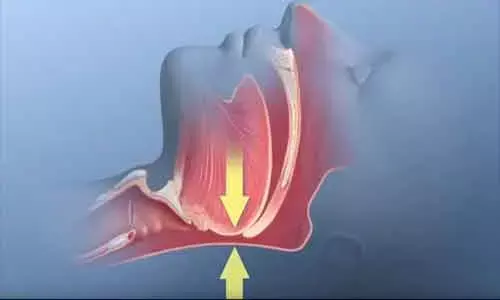- Home
- Medical news & Guidelines
- Anesthesiology
- Cardiology and CTVS
- Critical Care
- Dentistry
- Dermatology
- Diabetes and Endocrinology
- ENT
- Gastroenterology
- Medicine
- Nephrology
- Neurology
- Obstretics-Gynaecology
- Oncology
- Ophthalmology
- Orthopaedics
- Pediatrics-Neonatology
- Psychiatry
- Pulmonology
- Radiology
- Surgery
- Urology
- Laboratory Medicine
- Diet
- Nursing
- Paramedical
- Physiotherapy
- Health news
- Fact Check
- Bone Health Fact Check
- Brain Health Fact Check
- Cancer Related Fact Check
- Child Care Fact Check
- Dental and oral health fact check
- Diabetes and metabolic health fact check
- Diet and Nutrition Fact Check
- Eye and ENT Care Fact Check
- Fitness fact check
- Gut health fact check
- Heart health fact check
- Kidney health fact check
- Medical education fact check
- Men's health fact check
- Respiratory fact check
- Skin and hair care fact check
- Vaccine and Immunization fact check
- Women's health fact check
- AYUSH
- State News
- Andaman and Nicobar Islands
- Andhra Pradesh
- Arunachal Pradesh
- Assam
- Bihar
- Chandigarh
- Chattisgarh
- Dadra and Nagar Haveli
- Daman and Diu
- Delhi
- Goa
- Gujarat
- Haryana
- Himachal Pradesh
- Jammu & Kashmir
- Jharkhand
- Karnataka
- Kerala
- Ladakh
- Lakshadweep
- Madhya Pradesh
- Maharashtra
- Manipur
- Meghalaya
- Mizoram
- Nagaland
- Odisha
- Puducherry
- Punjab
- Rajasthan
- Sikkim
- Tamil Nadu
- Telangana
- Tripura
- Uttar Pradesh
- Uttrakhand
- West Bengal
- Medical Education
- Industry
Adenotonsillectomy has minimal benefit in pediatric OSA: JAMA Study

Sweden: Adenotonsillectomy (ATE) touted as the primary treatment for pediatric obstructive sleep apnea (OSA) was shown to be of minimal benefit in young children with mild or moderate OSA in comparison to watchful waiting, in a recent study. According to the study, published in the journal JAMA Otolaryngology-Head & Neck Surgery, there were only small differences obstructive apnea-hypopnea index (OAHI). There were however large improvements in quality of life after ATE.
"Children with moderate OSA should be considered for early ATE, while children with mild OSA and mild effect on the quality of life may benefit from a period of watchful waiting," wrote the authors.
Johan Fehrm, Department of Otorhinolaryngology, Karolinska University Hospital, Stockholm, Sweden, and colleagues determined whether ATE is more effective than watchful waiting for the treatment of otherwise healthy children with mild to moderate OSA.
This randomized clinical trial was conducted from December 2014 to December 2017 at the Otorhinolaryngology Department of the Karolinska University Hospital, Stockholm, Sweden. It involved a total of 60 children (2-4 years of age) with an obstructive apnea–hypopnea index (OAHI) score of 2 or greater and less than 10, were randomized to ATE (n = 29) or watchful waiting (n = 31). A total of 53 participants (88%; ATE, n = 25; watchful waiting, n = 28) completed the study.
The primary outcome was the difference between the groups in mean OAHI score change.
Key findings of the study include:
- Of the 60 included children, 34 (57%) were boys and the mean (SD) age at first polysomnography was 38 (9) months.
- Both groups had a decrease in mean OAHI score, and the difference in mean OAHI score change between the groups was small (−1.0), in favor of ATE.
- However, there were large differences between the groups in favor of ATE regarding the OSA–18 questionnaire (eg, total OSA–18 score).
- Also, a subgroup analysis of 24 children with moderate OSA (OAHI ≥5 and <10) showed a meaningful difference in mean OAHI score change between the groups in favor of ATE (−3.1).
- Of 28 children, 10 (36%) in the watchful waiting group received ATE after the follow-up, and 7 of these had moderate OSA at baseline.
"This randomized clinical trial found only small differences between the groups regarding changes in OAHI, but further studies are needed. However, there were large improvements in quality of life after ATE," wrote the authors.
"These results suggest that otherwise healthy children with mild OSA and mild effect on quality of life may benefit from watchful waiting, while children with moderate OSA should be considered for ATE," they concluded.
The study, "Effectiveness of Adenotonsillectomy vs Watchful Waiting in Young Children With Mild to Moderate Obstructive Sleep Apnea: A Randomized Clinical Trial," is published in the journal JAMA Otolaryngology-Head & Neck Surgery.
Dr Kamal Kant Kohli-MBBS, DTCD- a chest specialist with more than 30 years of practice and a flair for writing clinical articles, Dr Kamal Kant Kohli joined Medical Dialogues as a Chief Editor of Medical News. Besides writing articles, as an editor, he proofreads and verifies all the medical content published on Medical Dialogues including those coming from journals, studies,medical conferences,guidelines etc. Email: drkohli@medicaldialogues.in. Contact no. 011-43720751


